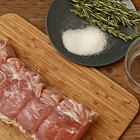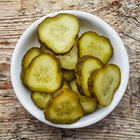
The pork leg cut, another name for ham, comes bone-in or boneless. Either style can be brined as long as it's fresh, but don't attempt to brine a smoked or cured ham; brining must occur prior to cooking. Brining, or soaking meat in a saltwater solution, imparts more moisture into the meat. It's an effective way of cooking a more tender, juicy pork leg, and it also provides some insurance against dried out ham if you cook it a bit too long.
Step 1
Rearrange the items in your refrigerator, and possible a shelf or two, too, so there's enough space for the large container or bucket you use to brine the pork leg. The ham must be fully immersed in water during brining and kept in the fridge.
Step 2
Fill the brining vessel with enough cold water to completely cover the fresh pork leg. Substitute a fruit juice, such as apple, orange or pineapple juice, for one-quarter to one-half of the water if you want the brine to also marinate the ham. You could also use soy sauce, tamari, red or white wine, cider vinegar, beer or another liquid, if it complements the recipe you're using to cook the pork leg.
Step 3
Dissolve about 3/4 cup of table salt -- use one without iodine, though -- per gallon of liquid in the brining solution. If you have kosher salt, use about 1 cup per gallon because it weighs less than table salt. While some brine recipes call for more salt, a pork leg is relatively high in sodium, so stick to as little added salt as possible or your ham may end up too salty.
Step 4
Balance the salinity of the brine and the resulting saltiness of the pork leg by adding a sweet component to the solution. About 1/2 cup per gallon of water suffices, but you might use a little less if you added a sweet brining liquid like a sweet red wine or a fruit juice; you might use a little more if you added a salty brining liquid like soy sauce or tamari. Honey or brown sugar are good picks if you're making a honey-glazed ham or if you used a fruit juice in the brine. Sugar, maple syrup and molasses are other options.
Step 5
Flavor the brining solution to taste with some spices or herbs if you're using it to marinate the meat, too. Use any fresh or dried seasonings that appear in the pork leg recipe you're preparing.
Step 6
Immerse the pork leg in the brining solution and move it into the refrigerator. Don't brine out on the counter, as bacteria grows quickly if the meat and brine isn't kept below 40 degrees Fahrenheit. Soak the pork leg for 12 to 24 hours. Less time can work, but is not as effective; don't brine longer, as the meat becomes excessively salty and the texture begins to degrade.
Related Articles

How to Brine a Pheasant

How to Brine a Boston Butt

Brine for a Deer Ham

How to Brine a Turkey Using Orange Juice

How to Make a Good Brine for Pork

How Do I Roast a Picnic Ham?

How to Brine a Goose

How to Remove a Salty Taste From Sliced ...

How to Brine a Ham With Sugar

How to Brine a Butterball Turkey

How to Brine Pork Loins

How to Brine Pork Roast

How to Make Salt Brine

How to Do Corned Pork

How to Brine a Duck Leg

How to Cook Pan Fried Deer Tenderloin

Can I Substitute Salt Pork for Smoked ...

How to Pickle Without Vinegar

Perfect Way to Cook a Pork Chop in the ...

Adding Vinegar to a Brine for Pork
References
Tips
- Wash your hands with warm water and soap after handling the raw pork leg.
- Discard the brine after use, as it's been contaminated by the uncooked ham. Like a marinade, it can technically be rendered safe for consumption by being boiled for 5 minutes, but unlike a marinade, a brining solution is far too salty to use as a sauce.
Writer Bio
Eric Mohrman is a food and drink, travel, and lifestyle writer living in Orlando, Florida. He has professional experience to complement his love of cooking and eating, having worked for 10 years both front- and back-of-house in casual and fine dining restaurants. He has written print and web pieces on food and drink topics for Visit Florida, Orlando Style Magazine, CrushBrew Magazine, Agent Magazine, Dollar Stretcher Magazine, The 863 Magazine and other publications.
Photo Credits
Brand X Pictures/Brand X Pictures/Getty Images